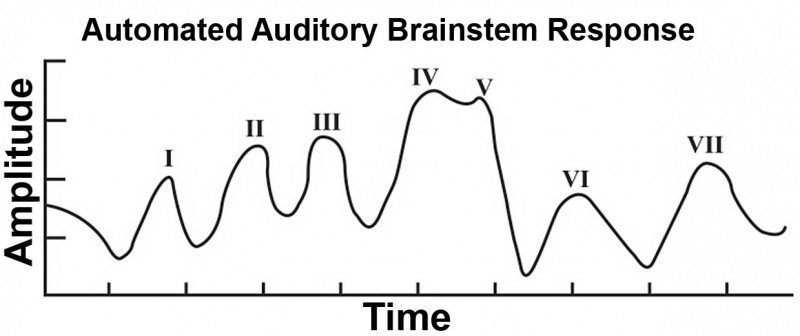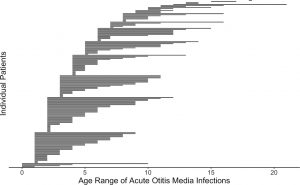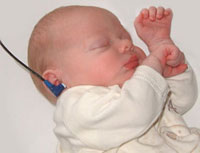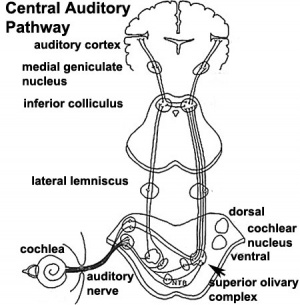Hearing test
| Embryology - 27 Apr 2024 |
|---|
| Google Translate - select your language from the list shown below (this will open a new external page) |
|
العربية | català | 中文 | 中國傳統的 | français | Deutsche | עִברִית | हिंदी | bahasa Indonesia | italiano | 日本語 | 한국어 | မြန်မာ | Pilipino | Polskie | português | ਪੰਜਾਬੀ ਦੇ | Română | русский | Español | Swahili | Svensk | ไทย | Türkçe | اردو | ייִדיש | Tiếng Việt These external translations are automated and may not be accurate. (More? About Translations) |
Introduction
The incidence of significant permanent hearing loss is approximately 1-3/1000 newborns. Neonatal hearing screening is carried out in the USA, UK and in Australia (2002 NSW Statewide Infant Screening Hearing Program, SWISH) There is a general guide giving a timetable for a number of simple responses that a neonate should make if hearing has developed normally (More? Neonatal Hearing Check List).
State Wide Infant Screening Hearing Program (SWISH) a newborn hearing testing program using an automated auditory response technology (AABR). Program was introduced in NSW Australia in 2002 across 17 area health service coordinators. It is thought that in NSW 86,000 births/year = 86-172 babies potentially born with significant permanent hearing loss.
The Automated Auditory Brainstem Response (AABR) test uses a stimulus which is delivered through earphones and detected by scalp electrodes. The test takes between 8 to 20 minutes and has a sensitivity 96-99%.
Some Recent Findings
|
| More recent papers |
|---|
|
This table allows an automated computer search of the external PubMed database using the listed "Search term" text link.
More? References | Discussion Page | Journal Searches | 2019 References | 2020 References Search term: Neonatal Hearing Test |
Automated Auditory Brainstem Response

| |||
| waves I and II arise ipsilaterally to the stimulus and reflect the action potential of the auditory nerve |
waves III, IV and V receive contralateral inputs |
||
The infant AABR test takes between 8 to 20 minutes, has a sensitivity 96-99%, and unlike other childhood auditory testing does not require a subject response.
The basis of a neonatal hearing test that uses a trigger stimulus delivered through earphones and subsequent brain electrical activity then detected by scalp electrodes. Then by computer analysis, averaging all the electrical activity following the trigger, peaks emerge reflecting signal passage activity through brain stem nuclei in the hearing central neural pathway.
An increased absolute latency has been seen to occur in premature infants related to decreased myelinization affecting the electrical conduction delays up to the brainstem.
An alternative and simple test (pass/refer) used at a later stage is otoacoustic emission testing.
Otoacoustic Emission Testing
(OAE) The basis of a simple infant hearing test of the inner ear. A small probe containing both a speaker producing "clicks" and a microphone to detect cochlea responses is placed inside the ear canal. Acoustic energy produced by vibration of the hair cells in response to the clicks is detected by the microphone within the probe. A more complex test that can be used at an earlier stage is the automated auditory brainstem response.
Wideband Acoustic Immittance
Wideband Acoustic Immittance (WAI) or Wideband Tympanometry (WT) shows the acoustic response properties of the middle ear over a broad range of frequencies and ear-canal pressures.[1][7]
Neonatal Hearing Check List
The timing and types of responses listed below reflect only a rough guide for the general population. Abnormalities in neurological, visual or motor skill development can also affect responses.
- Birth to 3 months - Reacts to loud sounds, Quiets to familiar voices or sounds, Makes cooing noises, Responds to speech by looking at speaker’s face
- 3 to 6 months - Turns eyes or head toward sounds, Starts to make speech-like sounds, Laughs and makes noises to indicate pleasure and displeasure
- 6 to 9 months - Babbles, ‘dada’‘ma-ma’‘baba’, Shouts/vocalises to get attention, Will often respond to ‘no’ and own name, Responds to singing and music
- 9 to 12 months - Imitates speech sounds of others, Understands simple words, eg ‘ball’,‘dog’, ‘daddy’, Turns head to soft sounds, First words emerge
- 12 to 18 months _ Appears to understand some new words each week, Follows simple spoken instructions, eg ‘get the ball’, Points to people, body parts or toys when asked, Continually learns new words to say although may be unclear
- 18 to 24 months - Listens to simple stories or songs, Combines two or more words in short phrases eg ‘more juice’
Hearing check list text based upon NSW Health Pamphlet - Why does my baby need a hearing check?
Neural Exam
The following are examples of simple assessment of development in early hearing and understanding.
| 12 month Behaviour | 18 month Behaviour | 30 month Behaviour |
|---|---|---|
| <html5media height="290" width="320">File:12mo 02.mp4</html5media> | <html5media height="290" width="320">File:18mo 02.mp4</html5media> | <html5media height="290" width="320">File:30mo 02.mp4</html5media> |
| Movie Source - Paul D. Larsen |
|---|
| Movies from the PediNeuroLogic Exam website are used by permission of Paul D. Larsen, M.D., University of Nebraska Medical Center and Suzanne S. Stensaas, Ph.D., University of Utah School of Medicine. Additional materials were drawn from resources provided by Alejandro Stern, Stern Foundation, Buenos Aires, Argentina; Kathleen Digre, M.D., University of Utah; and Daniel Jacobson, M.D., Marshfield Clinic, Wisconsin. The movies are licensed under a Creative Commons Attribution-NonCommerical-ShareAlike 2.5 License. |
Hearing Loss Risk Factors

The following selected genetic and environmental conditions have been identified as risk factors for hearing loss.
- syndrome known to be related to hearing loss
- close family history of congenital hearing impairment (parent / sibling)
- congenital abnormality of the head / neck (excluding minor pits/ ear tags)
- maternal infections during pregnancy such as HIV, TORCH - (Toxoplasmosis, Other (syphilis, varicella), Rubella, CMV, Herpes)
- meningitis / encephalitis
- jaundice requiring exchange transfusion
- ventilation greater than 5 days (excluding continuous positive airway pressure)
- amino glycoside antibiotic therapy for greater than 3 days
Australia
- New South Wales - State Wide Infant Screening Hearing Program (SWISH) was introduced in NSW Australia in 2002 across 17 area health service coordinators.
- Victoria - Victorian Infant Hearing Screening Program (VIHSP) provides statewide newborn hearing screening to babies born at all Victorian maternity hospitals.
- Northern Territory - Hearing health outreach services for Aboriginal and Torres Strait Islander children - July 2012 to December 2018 Report (16 October 2019)[9]
- 47% of Indigenous children who received a service had hearing loss
- 57% of Indigenous children who had hearing loss at their first service showed improvement at their last service
Latin America
The following data and modified text is from a recent review describing newborn hearing screening (NHS) activities in Latin America.[6]
- Chile - since July 2005, Chilean law has required targeted hearing screening using otoacoustic emissions (OAE) and auditory brainstem response (ABR) technology for all premature newborns born before 32 weeks and weighing less than 1500 g who are discharged from the 28 facilities with a neonatal intensive care unit.
- Costa Rica - since 2004, a few centers have been providing NHS services using OAE to screen some high-risk children.
- Guatemala - does not have legislation requiring NHS. In 2004, high-risk targeted NHS was implemented in one hospital in the capital city, and a second site was established in 2008. These NHS programs were started with donated OAE equipment and there were plans to expand as additional (donated) equipment became available. In 2008, the OAE equipment in the first hospital broke, and as of June 2009 it had not been repaired, which left only one hospital performing hearing screenings.
- Mexico - since February 2005, a national law was passed requiring hearing screening for all newborns and audiological evaluation. In July 2007, the program at HGM was expanded to include all newborns. Some NHS programs have been implemented in a few public and private hospitals around the country.
- Panama - since 2000, Panama has offered targeted NHS in some public and private birthing hospitals. There is no NHS law in place, but a local group is advocating for implementation of universal NHS.
- Puerto Rico - (Puerto Rico is a USA territory) and receives directives regarding health care initiatives from the U.S. government. An NHS program, Programa de Cernimiento Auditivo Neonatal Universal, operates in all birthing hospitals. The program was initiated in January 2000 and became required by law in December 2003.
- Uruguay - in 2000, Uruguay started implementing targeted and universal NHS in a limited number of public and private hospitals. Several hospitals in the capital city of Montevideo and one hospital in the city of Paysandú offer NHS.
References
- ↑ 1.0 1.1 Myers J, Kei J, Aithal S, Aithal V, Driscoll C, Khan A, Manuel A, Joseph A & Malicka AN. (2018). Development of a Diagnostic Prediction Model for Conductive Conditions in Neonates Using Wideband Acoustic Immittance. Ear Hear , , . PMID: 29509564 DOI.
- ↑ Long P, Wan G, Roberts MT & Corfas G. (2018). Myelin development, plasticity, and pathology in the auditory system. Dev Neurobiol , 78, 80-92. PMID: 28925106 DOI.
- ↑ Augustine AM, Jana AK, Kuruvilla KA, Danda S, Lepcha A, Ebenezer J, Paul RR, Tyagi A & Balraj A. (2014). Neonatal hearing screening--experience from a tertiary care hospital in southern India. Indian Pediatr , 51, 179-83. PMID: 24277966
- ↑ Tobe RG, Mori R, Huang L, Xu L, Han D & Shibuya K. (2013). Cost-effectiveness analysis of a national neonatal hearing screening program in China: conditions for the scale-up. PLoS ONE , 8, e51990. PMID: 23341887 DOI.
- ↑ Synnes AR, Anson S, Baum J & Usher L. (2012). Incidence and pattern of hearing impairment in children with ≤ 800 g birthweight in British Columbia, Canada. Acta Paediatr. , 101, e48-54. PMID: 21824192 DOI.
- ↑ 6.0 6.1 Gerner de Garcia B, Gaffney C, Chacon S & Gaffney M. (2011). Overview of newborn hearing screening activities in Latin America. Rev. Panam. Salud Publica , 29, 145-52. PMID: 21484013
- ↑ Sanford CA, Hunter LL, Feeney MP & Nakajima HH. (2013). Wideband acoustic immittance: tympanometric measures. Ear Hear , 34 Suppl 1, 65S-71S. PMID: 23900184 DOI.
- ↑ Norowitz HL, Morello T, Kupfer HM, Kohlhoff SA & Smith-Norowitz TA. (2019). Association between otitis media infection and failed hearing screenings in children. PLoS ONE , 14, e0212777. PMID: 30794686 DOI.
- ↑ Australian Institute of Health and Welfare 2019. Hearing health outreach services for Aboriginal and Torres Strait Islander children in the Northern Territory: July 2012 to December 2018. Cat no. [https://www.aihw.gov.au/reports/indigenous-health-welfare-services/hearing-health-outreach-services/contents/table-of-contents IHW 213]. Canberra: AIHW.
Search PubMed: neonatal hearing diagnosis | neonatal diagnosis | neonatal screening | Automated Auditory Brainstem Response | Otoacoustic Emission Testing
External Links
External Links Notice - The dynamic nature of the internet may mean that some of these listed links may no longer function. If the link no longer works search the web with the link text or name. Links to any external commercial sites are provided for information purposes only and should never be considered an endorsement. UNSW Embryology is provided as an educational resource with no clinical information or commercial affiliation.
- Australia
- Australian Hearing provides hearing services to clients eligible under the Australian Government Hearing Services Program.
- State Wide Infant Screening Hearing Program (SWISH)
- Victorian Infant Hearing Screening Program (VIHSP)
Terms
| Hearing Terms | ||
|---|---|---|
Hearing and Balance Development
|
Glossary Links
- Glossary: A | B | C | D | E | F | G | H | I | J | K | L | M | N | O | P | Q | R | S | T | U | V | W | X | Y | Z | Numbers | Symbols | Term Link
Cite this page: Hill, M.A. (2024, April 27) Embryology Hearing test. Retrieved from https://embryology.med.unsw.edu.au/embryology/index.php/Hearing_test
- © Dr Mark Hill 2024, UNSW Embryology ISBN: 978 0 7334 2609 4 - UNSW CRICOS Provider Code No. 00098G


